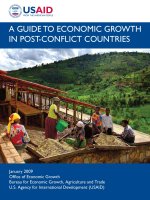Domestication in plants: A key to unexplored variability
Bạn đang xem bản rút gọn của tài liệu. Xem và tải ngay bản đầy đủ của tài liệu tại đây (130.15 KB, 6 trang )
Int.J.Curr.Microbiol.App.Sci (2019) 8(1): 133-138
International Journal of Current Microbiology and Applied Sciences
ISSN: 2319-7706 Volume 8 Number 01 (2019)
Journal homepage:
Review Article
/>
Domestication in Plants: A Key to Unexplored Variability
A. Chinthiya and R.K. Bhavyasree*
1
Center for Plant breeding and Genetics, Tamil nadu Agricultural University,
Coimbatore-641003, India
*Corresponding author
ABSTRACT
Keywords
Domestication,
Domestication
syndromes,
Variability, Crop wild
relatives, Progenitors
Article Info
Accepted:
04 December 2018
Available Online:
10 January 2019
Domestication is the process in which plants are genetically modified over
time by humans for traits that are more advantageous or desirable for
humans. A set of morphological, biochemical, and physiological traits that
distinguishes domesticated plants from their wild progenitor is known as
domestication syndrome. Reduction/loss of means of dispersal
reduction/loss of dormancy, compact growth habit, earliness, gigantism,
photoperiod insensitivity, reduction/loss of toxic substances is the major
elements of domestication syndrome. Studying the crop domestication in
detail will help us to uncover the hidden variability in crop wild relatives
and can help in further crop improvement and thereby ensure the food
security.
domestication done with the plant is genetic
modification for a character which is
advantageous or desirable for human use. In
short they became the pets of the humans. As
a result of domestication, a new plant form
arise which will easily meet out the human
needs.
Introduction
The nomadic man tried hard to survive. He
wandered all around to get the food. He
hunted and collected the food. In that journey
he began to keep some animals and plants
with him. There arise the era of
domestication. Domestication literally means
bringing under human management; it may be
of plant or animal. This phenomenon later
lead to agriculture changed the human life.
The nomadic man started settlements
eventually leading to civilizations. Plant
domestication plays a major role in
agriculture sector. What actually the
Where and how did it happen?
Several crops are having different areas of
distribution. The diversity includes its various
forma and the crop relatives. Centers of
diversity, place where more diversity was
found for a particular crop species and that
133
Int.J.Curr.Microbiol.App.Sci (2019) 8(1): 133-138
particular crop is believed to be originated
from that particular place. So, this originated
place is believed to be domesticated place of
the corresponding crop (Gepts, 2014). So
there are different centers of origin and
diversity for every crop. The domestication is
not a rapid process. It happened knowingly or
unknowingly by the action of our ancestors.
The basis of domestication is the selection.
Two key terms behind domestication is
‘Unconscious selection’ and ‘Conscious
selection’. Unconscious selection means the
work is not intentionally done which implies
that domestication happens in nature i.e.,
selection of most valued one is not done with
the thought of altering the breed. Conscious
selection means domestication is done with
intention. But, many of the changes due to
domestication are arisen from unconscious
selection (Zohary, 2004).
as per their needs. These selections later lead
to the evolutionary changes in the plants. The
plant evolved themselves as desirable pets for
the humans and develops some characters
which differentiate them from their wild
forms called as ‘domestication syndrome’.
Domestication syndromes
The alteration in the genetic component of the
plants that created the new cultivated types is
called as the plant domestication. The
domestication lead to the increase of those
traits that is favorable to humans. The most of
the domesticated plants completely depend on
the humans even for their survival and
propagation. For example the crops like maize
and cauliflower are such highly modified
crops. While some of the crops like carrot,
lettuce etc. were modestly modified when
compared to their wild forms. A common set
of traits in the domesticated plants that
differentiate themselves from the wild
progenitor is called as domestication
syndrome. In general, the grain crops will
have larger grains, higher grain weight, higher
grain yield etc. while the fruit crops have
larger and more number of fruits.
Domestication process
The domestication process requires three
major factors: Plant/animal, Human, and
Environment. The humans and the
environment influence the plants or animals
and lead to the formation of their
domesticated forms (Gepts, 2014). The
process of domestication can be broadly
divided into three stages. Viz., 1. Hunting –
Gathering stage, 2. Pre domestication
cultivation, 3. Emergence of true agriculture.
There are several traits which constitute to the
major domestication syndrome traits. The
larger fruits or grains is a major one in all
food crops as the human always selected for
the increased yield. As the agriculture crops
should have a determinate growth to harvest
them at a single stretch, it is also one of the
evolved trait during domestication. An
increase in apical dominance was there which
lead to the strong central stem in the
cultivated forms. Some of the plants reduced
the number of fruits by increasing the weight.
As the human cultivation doesn’t involves
any natural way of seed dispersal, the trait
was eliminated from the cultivated forms.
Some physiological traits also took place. The
dormancy is one of the important trait that is
In the first phase, the people started to search
for food and led a nomadic life. They mostly
hunted the food required for them. After that
they began to settle down which makes them
gatherers. The settled man went out to gather
food. They started collecting the seeds or the
propagules of the plants of their interest. They
started growing them near their settlements.
Thus the wild plants that they used for food
became the pets. They took care of their pets
and harvested and regrew them. There began
the agriculture. The selected the type of plants
134
Int.J.Curr.Microbiol.App.Sci (2019) 8(1): 133-138
lost during the domestication. In many of the
crops there was a bitter substance in the skin
like that in cucurbit crops. But the level of the
bitter substance is very less in cultivated
forms when compared with the wild
progenitors. The changes in photoperiod
insensitivity and synchronized flowering are
also involved in the process.
Fruitweight2.2 (fw2.2)
Fruitweight2.2 (fw2.2) is a major QTL
controlling fruit weight in tomato (Frary et
al., 2000). The exact function of this QTL is
unknown but it is supposed to a negative
regulator of cell division. The human
selection caused a lower expression in fruit
development causing higher fruit weight
compared to wild progenitor (Cong et al.,
2002).
Elements of domestication syndrome
Though there are several common traits those
evolved during the domestication, some of
them revolutionized the whole agriculture.
There are some major traits that are
characteristics of domesticated plants.
The large- and small-fruited alleles have no
differences in protein sequence, supporting
the model that changes in gene regulation
underlie the evolution of tomato fruit size as
controlled by fw2.2 (Nesbitt and Tanksley,
2002).
They are Loss of brittle rachis, Loss of
dormancy, Compact growth habit, Earliness,
Gigantism (in case of polyploidy evolution),
Photoperiod insensitivity, Loss of toxic
substances, which creates major disadvantage
in case of defense mechanism but increases
the value of edibleness (Gepts, 2014).
Teosinte glume architecture1 (tga1)
Teosinte glume architecture1 (tga1) was
identified as a QTL controlling the formation
of the casing that surrounds the kernels of the
maize ancestor, teosinte (Wang et al., 2005).
tga1 belongs to the family of transcriptional
regulators (Cardon et al., 1999).
Genes controlling domestication syndrome
Teosinte branched1 (tb1)
Consistent with this hypothesis, tga1 has
phenotypic effects on diverse traits including
cell lignification, silica deposition in cells,
three-dimensional organ growth, and organ
size (Dorweiler and Doebley, 1997).
Teosinte branched1 (tb1) gene was one of the
major gene or QTL reported which is related
to the domestication of maize. This gene
controls the lateral branching in maize. This
differentiates maize from its progenitor
teosinte due to the action of this gene
controlling the apical dominance (Doebley et
al., 1997; Doebley, 2004). The teosinte plants
are highly branched while the maize plant
have single stalk due to this gene which is a
member of transcriptional regulators of cell
cycles (Cubas et al.,1999; Kosugi and Ohashi,
2002). tb1 is the repressor of cell cycle genes
for axillary meristem outgrowth and
elongation (Li et al., 2005). The expression
studies indicate the higher expression of tb1
in maize (Doebley et al., 1997; Wang et al.,
1999).
Q gene
Q is a major gene responsible for wheat
domestication which affect the shattering of
spike, tenacity and compact spike in
cultivated forms (Simons et al., 2006).
Recently, Q is a member of the AP2 family of
plant-specific transcriptional regulators. This
gene family regulates traits related to
inflorescence structure and flowering. The
cultivated (Q) allele is expressed at a higher
level than the wild (q) allele.
135
Int.J.Curr.Microbiol.App.Sci (2019) 8(1): 133-138
fixed in a population and diversity gets
reduced. But, in case of selected gene in a
population only one type of alleles will be
fixed during domestication, the resultant
population will have high homogeneity.
Selective sweep refers variation in nucleotide
level will get reduced or eliminated. i.e.,
under natural condition, sudden increase in
the frequency of a new beneficial mutation
will be there. Before selection the population
has different types of alleles. But after
selection the frequency of some allele will get
increased which reduces the genetic diversity
(Ibarra et al., 2007). Ultimately, these two
factor causes reduction in genetic diversity
which is considered as a major impact of
domestication.
Shattering 4 (sh4)
shattering4 (sh4) is a major QTL controlling
shattering in rice which is mutated to lose
shattering in cultivated rice (Li et al., 2006).
Using transformation, Li et al., (2006) were
able to confirm that a single amino change in
the predicted DNA binding domain converts
plants from shattering to non-shattering. A
decrease in expression of the cultivated allele
as compared to the wild allele may also be
important.
qSH1
qSH1 is another major QTL controlling
shattering in rice that has recently been cloned
and shown to encode a homeobox containing
transcription factor (Konishi et al., 2006).
Grain number differences between rice
varieties are controlled by grain number1
(gn1),
which
encodes
an
oxidase/
dehydrogenase that degrades the plant
hormone cytokinin (Ashikari et al., 2005).
Super domestication
The process that leads to domesticate with
dramatically increased yield that could not be
selected in natural environments without new
technologies. The array of genome
manipulations that have been developed,
mainly enable barriers to gene exchange to be
overcome and have leads to superdomesticates with dramatically increased
yields, resistances to biotic and abiotic
stresses, new characters for the marketplace,
Hybrid rice can be considered as super
domesticate. Conversion of a crop from C3 to
C4 photosynthesis would certainly be a super
domesticate (Vaughan et al., 2007).
Impact on genetic diversity a genetic sweep
As we all know, selection causes changes in
allelic frequency of a population. As a result,
the variation found in a population will
dramatically get decrease due to fixation of
some alleles in a population. The causes of
decrease in genetic diversity will be of two
factors. They are Bottle neck effect and
Selective sweep. According to bottle neck
effect, initially, the population has enormous
alleles with all at equal frequency. After
domestication the new population will not
have all the allele. It will have the selected
allele at different level of frequency which
causes reduction in genetic frequency.
(Doebley et al., 2006)
Food security
Although the population-wide genomic
consequences of domestication offer several
predictions for levels of the genetic diversity
in crops, our understanding of how this
diversity corresponds to nutritional aspects of
crops is not well understood. Many studies
have found that modern cultivars have lower
levels of key micronutrients and vitamins.
Selection for palatability and increased yield
The neutral gene represents the presence of all
type of alleles in a population. During
domestication some favorable alleles alone
136
Int.J.Curr.Microbiol.App.Sci (2019) 8(1): 133-138
at
domestication
and
during
postdomestication divergence exacerbated the low
nutrient levels of many crops, although
relatively little work has examined this
question. Lack of diversity in modern
germplasm may further limit our capacity to
breed for higher nutrient levels, although little
effort has gone into this beyond a handful of
staple crops. This is an area where an
understanding of domestication across many
crop taxa may provide the necessary insight
for breeding more nutritious crops in a rapidly
changing world (Smykal et al., 2018).
selection during maize domestication.
Nature 398, 236–239.
Frary, A., Nesbitt, T. C., Frary, A., Grandillo,
S., Van Der Knaap, E., Cong, B. and
Tanksley, S. D. 2000. fw2. 2: a
quantitative trait locus key to the
evolution of tomato fruit size. Science,
289(5476), 85-88.
Cong, B., Liu, J., and Tanksley, S. D. 2002.
Natural alleles at a tomato fruit size
quantitative trait locus differ by
heterochronic regulatory mutations.
Proceedings of the National Academy of
Sciences, 99(21), 13606-13611.
Nesbitt, T. C., and Tanksley, S. D. 2002.
Comparative sequencing in the genus
Lycopersicon: implications for the
evolution of fruit size in the
domestication of cultivated tomatoes.
Genetics, 162(1), 365-379.
Cardon, G., Höhmann, S., Klein, J.,
Nettesheim, K., Saedler, H., and
Huijser,
P.
1999.
Molecular
characterisation of the Arabidopsis
SBP-box genes. Gene, 237(1), 91-104.
Dorweiler, J. E., and Doebley, J. 1997.
Developmental analysis of teosinte
glume architecture1: a key locus in the
evolution of maize (Poaceae). American
Journal of Botany, 84(10), 1313-1322.
Simons, K. J., Fellers, J. P., Trick, H. N.,
Zhang, Z., Tai, Y. S., Gill, B. S., and
Faris,
J.
D.
2006.
Molecular
characterization of the major wheat
domestication gene Q. Genetics, 172(1),
547-555.
Li, C., Zhou, A., and Sang, T. 2006. Rice
domestication by reducing shattering.
science, 311(5769), 1936-1939.
Konishi, S., Izawa, T., Lin, S. Y., Ebana, K.,
Fukuta, Y., Sasaki, T., and Yano, M.
2006. An SNP caused loss of seed
shattering during rice domestication.
Science, 312(5778), 1392-1396.
Ashikari, M., Sakakibara, H., Lin, S.,
Yamamoto, T., Takashi, T., Nishimura,
In conclusion, the crop wild relatives are as
important as the cultivated crops in terms of
variability. The progress in understanding
crop domestication will help the crop
scientists to uncover the unexplored
variability. So in this age of climate
instabilities, this variability can be utilized for
sustainable crop production or food security.
References
Doebley, J. 2004. The genetics of maize
evolution. Annu. Rev. Genet., 38, 37-59.
Cubas, P., Lauter, N., Doebley, J., and Coen,
E. 1999. The TCP domain: a motif
found in proteins regulating plant
growth and development. The Plant
Journal, 18(2), 215-222.
Kosugi, S., and Ohashi, Y. 2002. DNA
binding and dimerization specificity and
potential targets for the TCP protein
family. The Plant Journal, 30(3), 337348.
Li, C., Potuschak, T., Colón-Carmona, A.,
Gutiérrez, R. A., and Doerner, P. 2005.
Arabidopsis TCP20 links regulation of
growth and cell division control
pathways. Proceedings of the National
Academy of Sciences, 102(36), 1297812983.
Wang, R.L., Stec, A., Hey, J., Lukens, L., and
Doebley, J. 1999. The limits of
137
Int.J.Curr.Microbiol.App.Sci (2019) 8(1): 133-138
A. and Matsuoka, M. 2005. Cytokinin
oxidase regulates rice grain production.
Science, 309(5735), 741-745.
Pourkheirandish, M., Hensel, G., Kilian, B.,
Senthil, N., Chen, G., Sameri, M. and
Mascher, M. 2015. Evolution of the
grain dispersal system in barley. Cell,
162(3), 527-539.
Doebley, J. F., Gaut, B. S., and Smith, B. D.
2006. The molecular genetics of crop
domestication. Cell, 127(7), 1309-1321.
Ross-Ibarra, J., Morrell, P. L., and Gaut, B. S.
2007. Plant domestication, a unique
opportunity to identify the genetic basis
of adaptation. Proceedings of the
National
Academy
of
Sciences,
104(suppl 1), 8641-8648.
Vaughan, D. A., Balazs, E., and HeslopHarrison, J. S. 2007. From crop
domestication to super-domestication.
Annals of botany, 100(5), 893-901.
Smýkal, P., Nelson, M., Berger, J., and von
Wettberg, E. 2018. The impact of
genetic
changes
during
crop
domestication. Agronomy, 8(7), 119.
Gepts P. 2007. Crop Domestication as a
Long-term Selection Experiment. Plant
Breeding Reviews. Volume 24.
Gepts P. 2014. Domestication of Plants.
Elsevier. pp. 474-486.
Doebley, J., Stec, A., and Hubbard, L. 1997.
The evolution of apical dominance in
maize. Nature, 386(6624), 485.
How to cite this article:
Chinthiya, A. and Bhavyasree, R.K. 2019. Domestication in Plants: A Key to Unexplored
Variability. Int.J.Curr.Microbiol.App.Sci. 8(01): 133-138.
doi: />
138









